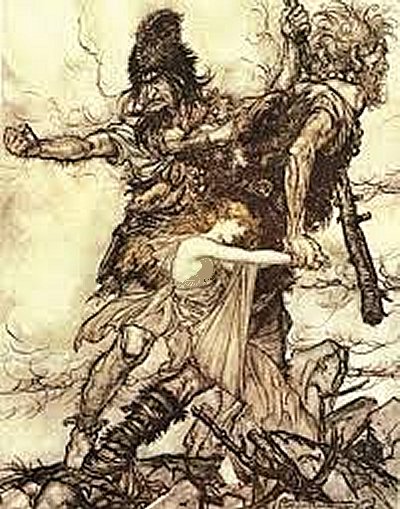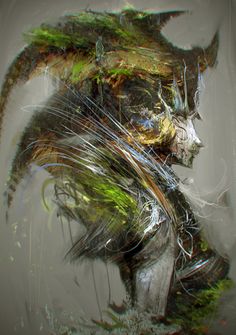 |
SPIRIT
LODGE
LIBRARY
Myth
& Lore
Page
41
|
(Main
Links of the site are right at the bottom of the page)
Some of the 86 pages in this Myth & Lore section are below.
The rest will be found HERE
Sprites, Nymphs &
Dryads
By CinnamonMoon

Elemental spirits that inhabit various
places in nature are called sprites, nymphs or dryads, names
that are used interchangeably. Generally invisible to mortals,
the particular kinds of nymphs were associated with the various
providences of nature amid the elements. The most heavily noted
source of reference is found in the Greek mythological teachings.
They were often found in the company of Pan and a search on
his lore will also aid your research.
A web search on any of these names
will bring you a wealth of information: Dryads, Nayads, Nereids,
Oceanids, Oreads will get you started if you are interested
in an extensive amount of information; as will "Bullfinche's
Mythology" as a resource reference book. I have some
notes on them to share here but did not note the sources since
it was intended for my own personal reference only and I did
not anticipate having to share it. Since there is an extensive
amount of information available here's a sample of what you
can expect to encounter on the Dryads (who are the woodland
tree nymphs).
DRYADS
Dryad females are very pretty, but not stunningly beautiful,
they are very slight in build, appearing child-like sometimes
even when they are very old. They cease to show physical age
at the equivalent of 20 human years. They favor greens and other
forest colors in their clothing. Dryads are very much like humans
in that their disposition varies from being to being. Most are
very open to other fae, although they are somewhat reclusive
and seldom leave the safety of the colony. They are friendly
and caring beings who never go out of their way to hurt anyone.
They normally avoid the mortal realm except for the occasional
curious child, and the occasional trickster who will travel
there to play tricks on them. They are also very trusting and
innocent in most cases, although they sometimes become jaded
towards certain things after that innocence leads them to bad
experiences. Indefinite in lifespans, they are very long lived,
but also tend to not keep track of the years after they leave
'childhood', which can vary from person to person.
Dryads normally live in colonies,
although some are solitary. Each being has its own tree which
it shares an extended understanding with, families share a tree,
until the child is old enough to choose one of her own. Dryad
trees are extremely noticeable, particularly in the winter,
it seems that their owner's immortality wears off on them so
they do not die off naturally as most trees do.
If a Dryad is killed her tree will
die, if a Dryad's tree is chopped down the Dryad will perish.
There is a colony of Dryads in the tamer area of the Wildewood…
However, wherever there are large wooded areas it is likely
that there are Dryads. The Dryads pay allegiance to the Seelie
Court (see Celtic folklore for this), and obey the rules thereof,
however they do have an overall Queen of their own, and an appointed
representative of her deals with any problems that should crop
up in individual colonies.
There are so few Dryad males that
it is easier to say there are none, as they are born perhaps
one a century. When the situation arises that there are males
in the colony, and some Dryads do bond with males of other species,
the gender roles are equal. A Dryad family is usually a mother
and children, since often a
male will take advantage of the Dryad's racial trait of trust
and waltz out without a trace.
A Dryad will choose her own mate,
and if she marries it will be for love. However, because there
are so few male dryads the marriages are usually inter-species
and rare because the Dryads seldom leave their colonies. However,
many men take advantage of the Dryad's trustful nature and leave
the scene as soon as the first child is born.
Dryads love children, no matter what
occurred to bring them into the world, in fact many times they
will find themselves happier with the child and no husband than
they would have had the male stayed around. The bond between
mother and child is incredibly strong.
NYMPHS
Naiades:
The Naiades (Naiads) (Nayads)
were nymphs of bodies of fresh water and were one of the three
main classes of water nymphs - the others being the Nereides
(nymphs of the Mediterranean Sea) and the Oceanides (nymphs
of the oceans). The Naiades presided over rivers, streams, brooks,
springs, fountains, lakes, ponds, wells, and marshes.
They were divided into various
subclasses:
Crinaeae (fountains),
Pegaeae (springs),
Eleionomae (marshes),
Potameides (rivers),
and Limnades or Limnatides (lakes).
Roman sources even assigned custody
of the rivers of Hades to Naiades classified as Nymphae Infernae
Paludis or the Avernales. The Naiad was intimately connected
to her body of water and her very existence seems to have depended
on it. If a stream dried up, its Naiad expired. The waters over
which Naiades presided were thought to be endowed with inspirational,
medicinal, or prophetic powers. Thus the Naiades were frequently
worshipped by the ancient Greeks in association with divinities
of healing, fertility and growth. The genealogy of the Naiades
varies according to geographic region and literary source. Naiades
were either daughters of Zeus, daughters of various river gods,
or simply part of the vast family of the Titan Oceanus. Like
all the nymphs, the Naiades were in many ways female sex symbols
of the ancient world and played the part of both the seduced
and the seducer.
Zeus in particular seems to have
enjoyed the favors of countless Naiades and the other gods do
not seem to have lagged far behind. The tale of the Naiad, Arethusa,
and her pursuit by the river god, Alpheus, is a classic example
of a lustful deity infatuated by a Naiad. The Naiades fell in
love with and actively pursued mortals as well. Classical literature
abounds with the stories of their love affairs with gods and
men and with the tales of their resulting children.
Naiads, along with the other
nymphs are extremely beautiful, and therefore usually very vain,
playful, and often shy. They are often seen playing in the waves
having a good time. All Naiads are connected to their body of
water and if that water gets polluted it effects them. It was
thought that their water was prophetic and so were they as a
result. Often they would fall in love with a mortal man or vs./vs.;
seducing men but sometimes the men could seduce them, as did
the god Zeus.
The Nereids were nymphs of
the Mediterranian Sea, and comprised of the 50 daughters of
Nereus (the sea god) and Doris. They are most often portrayed
as helpful and friendly, often to sailors in storms but they
can be vengeful creatures that destroy their enemies by creating
storms at sea. They enjoy riding on the backs of dolphins.
The Oceanids are like the
Nereids, and usually shy as well as helpful; they can be vengeful.
Crimaeae are the nymphs of fountains;
Limnades or Limnatides the nymphs of lakes;
Pagaeae are the nymphs of springs;
the Potameides the nymphs of rivers;
and the Eleionomae the nymphs of marshes.
Here are further listings:
Dryades/Adryades/Hamadryades: Ladies of the Trees/Ladies
of the Oak.
Oreiades/Orodemniades: Ladies of the Mountains
Meliades/Epimelides/Hamameliades: Ladies of the Fruit
Trees/Protectors of the fruit trees.
Daphnaie/Kissiai: Ladies
of the Laurel/Ladies of the Ivy
Alseides/Auloniades/Napaia/Hyleoroi: Ladies of the Grove/Ladies
of the Glen/Ladies of the Vale/Dell Watchers of the Wood.
Dryades/Oreiades: Ladies of oaks and pines, poplar and
ash, apple and laurel. At their birth trees sprung up from the
earth, trees to which their lives were closely tied. While the
tree still lived so did the nymph but when it died she died
with it. There were several classes of Dryades, each associated
with a particular type of tree.
The Meliai: Ash trees.
They sprang up from Gaia (Mother Earth) when she was impregnated
by the blood of the castrated Ouranos. The men of the Silver
Age married these nymphs (in the time before women were were
created) and mankind descended from there.
The Oreiades are the Ladies of the oaks and pines. Their
offspring, the five Daktyloi and five Hekaterides with subsequent
generations falling from the Oreiades and their brothers the
Satyres/Satyroi. The forests of ancient Greece were found mainly
in the mountains, and it was therefore natural for the Dryades
to be thought of as mountain dwellers.
NAMES OF DRYADES & OREIADES:
Aigeiros: The first black poplar-tree Hamadryas.
Ampelos: The first grape-vine Hamadryas (or alternatively
a satyr who was transformed into the vine, become a "male
Hamadryas").
Atlanteia: An Egyptian Hamadryas loved by Danaus prince
of Egypt.
Balanis: The first acorn-tree Hamadryas.
Byblis: A girl of Miletos in Karia transformed into a
Hamadryas.
Daphnis: A Phokian Oreias appointed by Gaia as the prophetess
of her oracle at Delphoi (in the time before the famed oracle
passed to Apollon).
Dryope: A Lokrian poplar or oak-tree Hamadryas Nymphe.
Originally a mortal woman she was transformed into a poplar-tree
Hamadryas by other Hamadryades.
Eidothea: A Malian Oreias of Mt. Othreis who was loved
by Poseidon.
Ekho/Echo: A Boiotian Oreias of Mt. Helikon and companion
of Hera. She was cursed to only repeat the words of others by
Hera. Ekho was also loved by Pan but spurned his advances and
she herself fell in love with the non-responsive Narkissos and
faded away in grief until only her echoing voice remained.
Erato: An Arkadian Dryas and wife of Nyktimos king of
Arkadia.
Karya: The first hazel or chestnut-tree Hamadryas.
Khelone: An Arkadian Oreias who refused to attend the
wedding of Zeus and Hera and was transformed into a tortoise
as punishment.
Klaia: A Messenian Oreias who had a shrine near her cavern
on Mt Kalathion.
Kraneia: The first cherry-tree
Hamadryas.
Kyllene: An Arkadian Oreias eponym of Mt Kyllene in Arkadia.
She was the wife of Pelasgos the very first Arkaidan king.
Morea: The first mulberry-tree Hamadryas.
Nomia: An Arkadian Oreias and eponym of the Nomian Mountains
in Arkadia.
Othreis: A Malian Oreias eponym of Mount Othrys. She
was loved by both Apollon and Zeus.
Penelopeia: An Arkadian Oreias of Mount Kyllene. She
was the mother of the god Pan by Hermes.
Phigalia: An Arkadian Oreias and eponym of the Arkadian
town of Phigalia.
Phoibe: An Egyptian Hamadryas loved by Danaus prince
of Egypt.
Pitys: An Oreias loved by Pan. She fled his advances
and was transformed into a pine-tree.
Ptelea: The first elm-tree Hamadryas.
Sinoe: An Arkadian Oreias and eponym of Mount Sinoe in
Arkadia. She was the nurse of Pan.
Sose: An Oreias prophetess loved by Hermes.
Sphragitides: The Oreiades of an oracle located on Mount
Kithairon in Attika.
Syke: The first fig-tree Hamadryas.
Tithorea: An Arkadian Dryas and eponym of the Arkadian
town of Tithorea.
|
|
|
|
|
|
|
|
|
|
|
|
Libraries
are on this row
|
|
|
INDEX
Page 3
(Main Section, Medicine Wheel, Native Languages &
Nations, Symbology)
|
|
INDEX
Page 5
(Sacred Feminine & Masculine, Stones & Minerals)
|
|
|
|
|
|
|
©
Copyright: Cinnamon Moon & River WildFire Moon (Founders.)
2000-date
All rights reserved.
Site
constructed by Dragonfly
Dezignz 1998-date
|
|